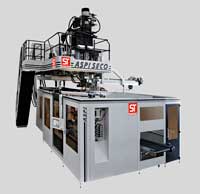ST sees renewed interest in sequential blow moulding

Italy’s extrusion blow moulding machine manufacturer ST Soffiaggio Tecnica says its recent sales confirm a renewed interest in sequential suction technology, which in previous years had seen a significant decrease when compared with the "boom" in requests for single-material suction technology.
It recently delivered three of its Aspi Seco machines to European and Korean Tier 1 component suppliers for the automotive industry. The machines will be used for the production of sequential extrusion blow moulded engine compartment ducts.
The first machine will go into production in Turkey, in what it says is one of the most important countries for the production of vehicles. The second blow moulding machine marks a further milestone for the company, being the first one destined for the fast-growing Indian automotive industry. Besides having an important local automotive industry, India also serves as a hub for the major foreign OEM manufacturers.
Last year, it also delivered a similar type machine to the DuPont European technical centre in Meyrin (Geneva).
The Aspi series blow moulding machines are supplied in the Seco configuration when it is necessary to produce parts with two different materials arranged in sequence. This sequential coextrusion utilises a parison that presents, in an alternating manner, different physical-mechanical characteristics. In this way it is possible to obtain manufactured articles with flexible parts and more rigid sections, thereby avoiding the time and cost of assembling more components. This technology also reduces the product cost, compared to a single-material solution, because each of the two resins is used only in those sections where it is needed.
The two new machines have the same clamping unit (with maximum opening of 1,400 mm) and identical plasticization units (two 60 mm extruders), but differ in some other characteristics: the clamping forces are 15 and 20 tonnes respectively, and the accumulator head capacities are 1 and 1.5 litres. A feature of both machines - not common on this bi-material typology - is the possibility to reach a process temperature in excess of 350°C. This characteristic makes them suitable for processing not only any technical resin available today for blow moulded engine compartment parts, but also new plastic materials that could be developed in the coming years for applications at even higher temperatures, says the machine maker.
(PRA)Copyright (c) 2017 www.plasticsandrubberasia.com. All rights reserved.
















































